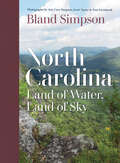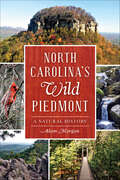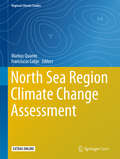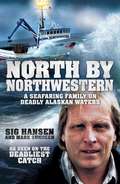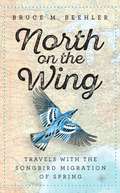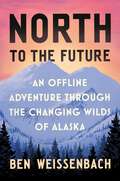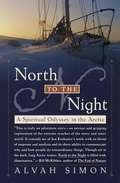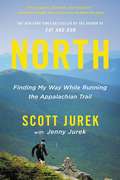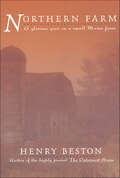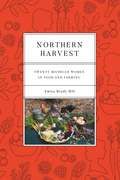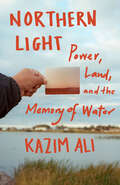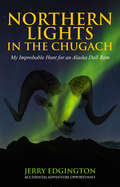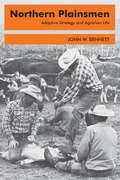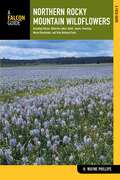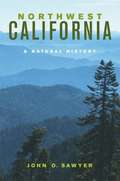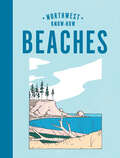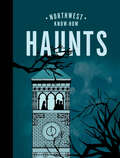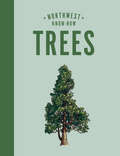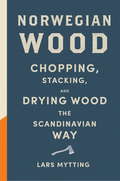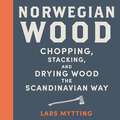- Table View
- List View
North Carolina: Land of Water, Land of Sky
by Bland SimpsonBland Simpson, the celebrated bard of North Carolina's sound country, has blended history, observation of nature, and personal narrative in many books to chronicle the people and places of eastern Carolina. Yet he has spent much of his life in the state's Piedmont, with regular travels into its western mountains. Here, for the first time, Simpson brings his distinctive voice and way of seeing to bear on the entirety of his home state, combining storytelling and travelogue to create a portrait of the Old North State with care and humor. Three of the state's finest photographers come along to guide the journey: Simpson's wife and creative partner, Ann Cary Simpson, professional photographer Scott Taylor, and writer and naturalist Tom Earnhardt. Their photos, combined with Simpson's rich narrative, will inspire readers to consider not only what North Carolina has been and what it is but also what we hope it will be. This book belongs on the shelf of longtime residents, newcomers, and visitors alike.
North Carolina’s Wild Piedmont: A Natural History (Natural History)
by Adam MorganThe North Carolina Piedmont is rich in natural beauty and wildlife. Home to eleven state parks, three state natural areas, a national wildlife refuge and a national forest, the region offers more than just gently rolling hills. Tour the wild wine vines in Medoc Mountain State Park, marvel at the floodplains of the Haw River and follow the migratory birds in Pee Dee National Wildlife Refuge. Experience the natural history, field research, interviews with park rangers and firsthand experiences of the state's largest physiographic region. Author Adam Morgan joins in a rich tradition of nature writing to paint the majestic beauty and raw power of North Carolina's wild Piedmont.
North Coast Journey: The Magic of Scotland's Northern Highlands
by Brigid BensonEnjoy the local color and majestic scenery of the Scottish Highlands with this essential road trip guide along the scenic North Coast 500. Known as Scotland&’s Route 66, the North Coast 500 takes travelers on a winding journey across northern Scotland&’s breathtaking coastline. Acclaimed Scottish travel writer Brigid Benson guides you on a journey that begins in the charming city of Inverness, then weaves westward to the historic village of Applecross and up the Atlantic coast to the most northerly points in Britain before heading back to Inverness along the North Sea. In addition to stunning mountains, moors, lochs and beaches, the route also features exquisite towns and villages, castles, distilleries and breweries. Benson divides the route into manageable daily itineraries, suggesting where to discover history, observe wildlife, meet great local characters, shop at quirky stores, taste outstanding food, drink in friendly bars and cafes, and stand in awe of amazing sights. She also recommends campsites, inns and other places to stay, along with places to picnic, swim, surf, walk and stargaze.&“For Scottish travel it doesn&’t get better than North Coast Journey, an eco-friendly, common sensical, well-researched foray around the locale of the North Coast 500 and beyond.&” —The Scotsman, UK
North Sea Region Climate Change Assessment
by Markus Quante Franciscus ColijnThis book offers an up-to-date review of our current understanding of climate change in the North Sea and adjacent areas, as well as its impact on ecosystems and socio-economic sectors. It provides a detailed assessment of climate change based on published scientific work compiled by independent international experts from climate-related disciplines such as oceanography, atmospheric sciences, marine and terrestrial ecology, using a regional evaluation and review process similar to that of the Intergovernmental Panel on Climate Change (IPCC). It provides a comprehensive overview of all aspects of our changing climate, discussing a wide range of topics including past, current and future climate change, and climate-related changes in marine, terrestrial and freshwater ecosystems. It also explores the impact of climate change on socio-economic sectors such as fisheries, agriculture, coastal zone management, coastal protection, urban climate, recreation/tourism, offshore activities/energy, and air pollution.
North To Adventure
by K. M. PeytonNick knows he wants to work on the crew of a ship, so when his uncle puts together a crew for the Nimbus to go north looking for the Puffin, which was lost years earlier, Nick becomes the most junior member of its crew. In the rough arctic seas and landscape, Nick and his eskimo friend Utak save the day and find out the truth about the Puffin.
North by Northwestern: A Seafaring Family on Deadly Alaskan Waters
by Mark Sundeen Sig HansenSig Hansen has been a star of the Channel 4's The Deadliest Catch from the pilot to the present. Seen in over 150 countries, the show attracts more than 49 million viewers per season, making it one of the most successful series in the history of cable TV. With its daredevil camera work, unpredictably dangerous weather, and a setting as unforgivable and unforgettable as the frigid Bering Sea, The Deadliest Catch is unlike anything else on television. But the weatherworn fishermen of the fishing vessel Northwestern have stories that don't come through on TV. For Sig Hansen and his brothers, commercial fishing is as much a part of their Norwegian heritage as their names. Descendents of the Vikings who roamed and ruled the northern seas for centuries, the Hansens' connection to the sea stretches from Alaska to Seattle and all the way to Norway. And after twenty years as a skipper on the commercial fishing vessel the Northwestern -- which was his father's before him -- Sig has lived to tell the tales. To be a successful fisherman, you need to be a mechanic, navigator, welder, painter, carpenter, and sometimes, a firefighter. To be a successful fisherman year after year, you need to be a survivor. This is the story of a family of survivors; part memoir and part adventure tale, North by Northwestern brings readers on deck, into the dockside bars and into the history of a family with a common destiny. Built around a gripping tale of a deadly shipwreck like The Perfect Storm, North by Northwestern is the multi-generational tale of the Hansen family, a clan of tough Norwegian-American fishermen who, through the popularity of The Deadliest Catch, have become modern folk-heroes.
North on the Wing: Travels with the Songbird Migration of Spring
by Bruce M. Beehler John T. AndertonThe story of an ornithologist's journey to trace the spring migration of songbirds from the southern border of the United States through the heartland and into Canada.In late March 2015, ornithologist Bruce M. Beehler set off on a solo four-month trek to track songbird migration and the northward progress of spring through America. Traveling via car, canoe, and bike and on foot, Beehler followed woodland warblers and other Neotropical songbird species from the southern border of Texas, where the birds first arrive after their winter sojourns in South America and the Caribbean, northward through the Mississippi drainage to its headwaters in Minnesota and onward to their nesting grounds in the north woods of Ontario. In North on the Wing, Beehler describes both the epic migration of songbirds across the country and the gradual dawning of springtime through the U.S. heartland--the blossoming of wildflowers, the chorusing of frogs, the leafing out of forest canopies--and also tells the stories of the people and institutions dedicated to studying and conserving the critical habitats and processes of spring songbird migration. Inspired in part by Edwin Way Teale's landmark 1951 book North with the Spring, this book--part travelogue, part field journal, and part environmental and cultural history--is a fascinating first-hand account of a once-in-a-lifetime journey. It engages readers in the wonders of spring migration and serves as a call for the need to conserve, restore, and expand bird habitats to preserve them for future generations of both birds and humans.
North to the Future: An Offline Adventure through the Changing Wilds of Alaska
by Ben WeissenbachHailed as a &“worthy successor&” to John McPhee (Kirkus Reviews), Ben Weissenbach —a digital native with little prior wilderness experience—embarks on a series of scientific adventures across the wilds of Alaska with some of the state's most distinguished and audacious researchers. At the age of twenty, college student Ben Weissenbach went north to Arctic Alaska armed with little more than inspiration from his literary heroes and a growing interest in climate change. What met him there was a world utterly unlike the 21st century Los Angeles in which he grew up—a land of ice, rock, and grizzlies seen by few outside a small contingent of scientists with big personalities. There&’s Roman Dial, the larger-than-life ecologist with whom Ben walks and rafts a thousand miles across Alaska&’s Brooks Range. There&’s Kenji Yoshikawa, the reindeer-herding permafrost expert who leaves Ben alone for eleven days to care for his off-grid homestead, where temperatures drop to -49 degrees Fahrenheit. And there&’s Matt Nolan, the independent glaciologist who flies him to the largest glaciers in the American Arctic. As these scientists teach Ben to read Alaska's warming landscape, he confronts the limits of digital life and the complexity of the world beyond his screens. He emerges from each adventure with a new perspective on our modern relationship to technology and a growing wonder for our fast-changing—ever-changing—natural world.
North to the Night: A Spiritual Odyssey in the Arctic
by Alvah SimonIn June 1994 Alvah Simon and his wife, Diana, set off in their 36-foot sailboat to explore the hauntingly beautiful world of icebergs, tundra, and fjords lying high above the Arctic Circle. Four months later, unexpected events would trap Simon alone on his boat, frozen in ice 100 miles from the nearest settlement, with the long polar night stretching into darkness for months to come. With his world circumscribed by screaming blizzards and marauding polar bears and his only companion a kitten named Halifax, Simon withstands months of crushing loneliness, sudden blindness, and private demons. Trapped in a boat buried beneath the drifting snow, he struggles through the perpetual darkness toward a spiritual awakening and an understanding of the forces that conspired to bring him there. He emerges five months later a transformed man. Simon's powerful, triumphant story combines the suspense of Into Thin Air with a crystalline, lyrical prose to explore the hypnotic draw of one of earth's deepest and most dangerous wildernesses.
North: Finding My Way While Running the Appalachian Trail
by Scott Jurek Jenny JurekFrom the author of the bestseller Eat and Run, a thrilling new memoir about his grueling, exhilarating, and immensely inspiring 46-day run to break the speed record for the Appalachian Trail.Scott Jurek is one of the world's best known and most beloved ultrarunners. Renowned for his remarkable endurance and speed, accomplished on a vegan diet, he's finished first in nearly all of ultrarunning's elite events over the course of his career. But after two decades of racing, training, speaking, and touring, Jurek felt an urgent need to discover something new about himself. He embarked on a wholly unique challenge, one that would force him to grow as a person and as an athlete: breaking the speed record for the Appalachian Trail. North is the story of the 2,189-mile journey that nearly shattered him.When he set out in the spring of 2015, Jurek anticipated punishing terrain, forbidding weather, and inevitable injuries. He would have to run nearly 50 miles a day, every day, for almost seven weeks. He knew he would be pushing himself to the limit, that comfort and rest would be in short supply -- but he couldn't have imagined the physical and emotional toll the trip would exact, nor the rewards it would offer.With his wife, Jenny, friends, and the kindness of strangers supporting him, Jurek ran, hiked, and stumbled his way north, one white blaze at a time. A stunning narrative of perseverance and personal transformation, North is a portrait of a man stripped bare on the most demanding and transcendent effort of his life. It will inspire runners and non-runners alike to keep striving for their personal best.
Northeast Foraging: 120 Wild and Flavorful Edibles from Beach Plums to Wineberries (Regional Foraging Series)
by Leda Meredith“An invaluable guide for the feast in the East.” —Hank Shaw, author of the James Beard Award–winning website Hunter Angler Gardener Cook The Northeast offers a veritable feast for foragers, and with Leda Meredith as your trusted guide you will learn how to safely find and identify an abundance of delicious wild plants. The plant profiles in Northeast Foraging include clear, color photographs, identification tips, guidance on how to ethically harvest, and suggestions for eating and preserving. A handy seasonal planner details which plants are available during every season. Thorough, comprehensive, and safe, this is a must-have for foragers in New York, Connecticut, Massachusetts, Maine, New Hampshire, Vermont, Pennsylvania, New Jersey, Delaware, and Rhode Island.
Northeast Medicinal Plants: Identify, Harvest, and Use 111 Wild Herbs for Health and Wellness
by Liz NevesWildcraft your way to wellness! In Northeast Medicinal Plants, Liz Neves is your trusted guide to finding, identifying, harvesting, and using 111 of the region&’s most powerful wild plants. You&’ll learn how to safely and ethically forage, and how to use wild plants in herbal medicines including teas, tinctures, and salves. Plant profiles include clear, color photographs, identification tips, medicinal uses and herbal preparations, and harvesting suggestions. Lists of what to forage for each season makes the guide useful year-round. Thorough, comprehensive, and safe, this is a must-have for foragers, naturalists, and herbalists in Connecticut, Maine, Massachusetts, New Hampshire, New Jersey, New York, Pennsylvania, Rhode Island, and Vermont.
Northern Farm: A Glorious Year on a Small Maine Farm
by Henry BestonIn the tradition of his well-loved The Outermost House, Henry Beston's Northern Farm captures "the elusive magic of a year on a Kennebee farm...in truly beautiful prose" (Kirkus Reviews). Among the blue-white shadows and graceful curves of freshly fallen snow, the first rains of spring, and the quiet green of an early summer morning, Beston brings the reader into an inescapable alliance with the natural world. He translates the philosophy of the Maine farmer into terms as applicable in Manhattan as on the Kennebee. One of the great classics of American nature writing, Northern Farm is inspiring reading and ranks as one of Beston's most memorable and lyrical works.HENRY BESTON (1888-1968) was the author of many books, including The Outermost House, White Pine and Blue Water, and The St. Lawrence.
Northern Harvest: Twenty Michigan Women in Food and Farming (Painted Turtle)
by Emita Brady HillNorthern Harvest: Twenty Michigan Women in Food and Farming looks at the female culinary pioneers who have put northern Michigan on the map for food, drink, and farming. Emita Brady Hill interviews women who share their own stories of becoming the cooks, bakers, chefs, and farmers that they are today—each even sharing a delicious recipe or two. These stories are as important to tracing the gastronomic landscape in America as they are to honoring the history, agriculture, and community of Michigan. Divided into six sections, Northern Harvest celebrates very different women who converged in an important region of Michigan and helped transform it into the flourishing culinary Eden it is today. Hill speaks with orchardists and farmers about planting their own fruit trees and making the decision to transition their farms over to organic. She hears from growers who have been challenged by the northern climate and have made exclusive use of fair trade products in their business. Readers are introduced to the first-ever cheesemaker in the Leelanau area and a pastry chef who is doing it all from scratch. Readers also get a sneak peek into the origins of Traverse City institutions such as Folgarelli’s Market and Wine Shop and Trattoria Stella. Hill catches up with local cookbook authors and nationally known food writers. She interviews the founder of two historic homesteads that introduce visitors to a way of living many of us only know from history books. These oral histories allow each woman to tell her story as she chooses, in her own words, with her own emphasis, and her own discretion or indiscretions. Northern Harvest is a celebration of northern Michigan’s rich culinary tradition and the women who made it so. Hungry readers will swallow this book whole.
Northern Light: Power, Land, and the Memory of Water
by Kazim AliAuthor is an acclaimed poet with four published collections of poems, her most recent the majorly successful Oceanic; her debut nonfiction book will appeal to the massive audience she's garnered through previous publications as well as her 18K followers on social media We expect strong blurbs from acclaimed writers Kiese Laymon, Ross Gay, and Nicole Chung Cover and interior art contributed by illustrator Fumi Nakamura; interior will be published in full-color, making it a gorgeous package and perfect gift book Audiobook published and distributed in tandem with publication, read by author Book's distinct engagement with joy, nature, science, the environment, memoir, and the experiences of people of color provides opportunities for wider coverage and crossover into larger markets
Northern Lights in the Chugach: My Improbable Hunt for an Alaska Dall Ram
by Jerry EdgingtonMy hunt for a Dall ram in the Chugach Mountains of Alaska became an epic adventure and stretched me beyond my limits, or so I thought. High on the rocky face of a steep mountainside, I found myself both physically and mentally spent. Exhaustion and confusion are a dangerous combination in a spot like that. Sweat stung my eyes and ran off my nose. My heartbeat pulsed in my ears and my arms and legs were limp with fatigue. I reached deep for a little more grit and climbed on. At the top of the next pitch I found a flat section of grass about the length of my body, an oasis and a reprieve from the misery. Life altering epiphanies come at a price. Amid the northern nights in the Chugach Mountains I found a bigger world than I'd ever known.
Northern Plainsmen: Adaptive Strategy and Agrarian Life
by John W. BennettA study of a rural region and plural society, this book is a distinctive contribution to anthropology, in that it brings the conceptual framework of that discipline to bear on a contemporary agrarian society and its historical development, rather than on peasant or tribal peoples; cultural ecology, in that it shows the nature of the adaptations of four distinctive social groups to the environment of the Canadian Great Plains; the study of social and economic change, as it describes cultural patterns and mechanisms that are relevant to agrarian development the world over; and North American studies, in as much as it deals with community life in the classic sequence of settlement of the Western Plains.The book is, focused throughout on the adaptation of human societies to their environment. Four groups are described: the Cree Indians, the aboriginal inhabitants of the area who have lost all organic relationship to natural resources and who have devised ingenious methods for manipulating the social environment; ranchers, whose specialized production is based upon resources used in their natural state; homestead farmers, whose maladjusted small-farm economy, after initial setbacks, achieved a degree of stability through interventions by government in their adaptations to nature and the market economy; and the Hutterian Brethren, whose adaptation consisted primarily of the introduction to the region of a new kind of social organization.This book combines the anthropological concept of culture and the framework of ecology in the study of a modern social milieu; it focuses on a region rather than on a single culture, people, or community, so that the interplay of several social groups can be appreciated; and it elaborates contemporary anthropological and ecological theory in a manner that makes it applicable to the understanding of contemporary agrarian societies.John W. Bennett was emeritus professor of anthropology at Washington University, St. Louis. He served as presid
Northern Rocky Mountain Wildflowers: Including Glacier, Waterton Lakes, Banff, Jasper, Kootenay, Mount Revelstoke, and Yoho National Park (Wildflower Series)
by H. Wayne PhillipsField guide to more than 300 wildflowers conveniently arranged for easy identification. Includes vibrant color photos and descriptions.
Northwest California: A Natural History
by John O. SawyerNorthwestern California is mainly known for its majestic redwood forests and incomparable coastline, but there is much more in its rich biota and scenery. The forests are part of the most diverse temperate coniferous forest in the world. Rugged mountains, numerous lakes, wilderness areas, and wild rivers attract outdoor enthusiasts and geologists came here to refine the theory of plate tectonics. Distilling a vast amount of knowledge, this book is the starting point for anyone who wants to explore the biological and geographical richness of northwestern California. John O. Sawyer describes the famous forests and varied landscapes from a geographic perspective. He explains its long geological history and the changing roles of fire and land use. The result of a lifetime of work, his rich narrative illustrates how the region, in many ways the least modified portion of the state, is a place where plants and animals have been shielded from extinction. Sawyer documents the restoration of dunes and forests, the control of nonnative plant invasions, and innovative approaches to restoring rivers so they can support thriving fisheries.
Northwest Know-How: Beaches
by Rena PriestEntertaining, educational and highly giftable, Northwest Know-How: Beaches showcases the majestic, quirky, and unique beaches of the Washington and Oregon coastline through facts, history, legend, and lovely illustrations.There are few things more treasured in the Pacific Northwest than its beaches. This celebratory guide features more than 30 favorite coastal and island beaches in Washington and Oregon, providing tips for visiting, fun facts, natural history, and native lore. Charming illustrations will capture the roar of the surf, the call of the wildlife, and the beauty of our beaches. Sure to delight the avid beachcomber and curious visitor alike, this makes the perfect gift and guide for PNW beach-lovers and nature enthusiasts.
Northwest Know-How: Haunts
by Bess LovejoyEntertaining, educational and highly giftable, Northwest Know-How: Haunts showcases the haunted hotspots, cemeteries and graveyards, ghost towns, and curiosities in Oregon and Washington.True crime and the supernatural are more popular than ever and Northwest Know-How: Haunts explores the ghosts, legends, and haunted spots of the Pacific Northwest. From the many haunted spots of Seattle&’s Pioneer Square and Pike Place Market to Oregon&’s many haunted hotels, lighthouses, and theaters, this book uncovers the events that inspired the hauntings as well as the reports of the hauntings themselves. Read about the ghost of Simon Benson, a teetotaling spirit who has been known to knock over drinks at his namesake Benson Hotel in Portland. And discover why it might be prudent to steer clear of the honeymoon suite at the Columbia Gorge Hotel. Spectral sightings extend to the water as well: a ghost ship appears off Seattle&’s Pier 70…and reputedly foretells doom. Haunts will be a must-have for anyone who likes their history with a side of spooky.
Northwest Know-How: Trees
by Karen Gaudette BrewerAn entertaining and educational guide, Northwest Know-How: Trees introduces 54 of the Pacific Northwest's most engaging and impressive varieties, providing key identification features, statistics, facts, and beautiful line-art renderings of the awe-inspiring sentinels that dot our landscapeTrees in the Pacific Northwest are as varied as they are majestic. This celebratory guide features 54 of the most intriguing varieties in the region, providing identification tips, statistics, and fun facts for each. In addition, each profile will be paired with beautiful illustrations showing the full silhouette along with finer details such as a flower or leaf. Delighting both the curious observer and experienced arborist alike, this collection makes a perfect gift for the tree lover in your life.
Norwegian Wood: The guide to chopping, stacking and drying wood the Scandinavian way
by Lars MyttingTHE DEFINITIVE WOOD-CUTTER'S BIBLE - THE BESTSELLING, YEAR-ROUND GUIDE TO CHOPPING, STACKING AND DRYING WOOD "The book has spread like wildfire" Daily Mail"A how-to book with poetry at its heart" T.L.S."A step-by-step guide to preparing your wood store" IndependentWhether you're a seasoned woodcutter, or your passion is yet to be kindled, NORWEGIAN WOOD is an entertaining guide for year-round wood management, and the perfect gift.Chopping and stacking wood is a pastime where the world makes sense once more. Because our relationship to fire is so ancient, so universal, it seems that in learning about wood, you can also learn about life.And who better to impart this wisdom than an expert from Scandinavia, where the extreme climate has obliged generations to hone and share their skills with tools, wood and heat production. Lars Mytting has distilled the wisdom of enthusiasts, from experienced lifelong growers, stackers and burners to researchers and professionals of combustion and tree culture.Part guide to the best practice in every aspect of working with this renewable energy source, part meditation on the human instinct for survival, this definitive handbook on the art of chopping, stacking and drying wood in the Scandinavian way has resonated across the world, with more than a million copies sold worldwide.More than 175,000 copies sold in English editions. The book that defined a genre.
Norwegian Wood: The guide to chopping, stacking and drying wood the Scandinavian way
by Lars MyttingTHE DEFINITIVE WOOD-CUTTER'S BIBLE - THE BESTSELLING, YEAR-ROUND GUIDE TO CHOPPING, STACKING AND DRYING WOOD "The book has spread like wildfire" Daily Mail"A how-to book with poetry at its heart" T.L.S."A step-by-step guide to preparing your wood store" IndependentWhether you're a seasoned woodcutter, or your passion is yet to be kindled, NORWEGIAN WOOD is an entertaining guide for year-round wood management, and the perfect gift.Chopping and stacking wood is a pastime where the world makes sense once more. Because our relationship to fire is so ancient, so universal, it seems that in learning about wood, you can also learn about life.And who better to impart this wisdom than an expert from Scandinavia, where the extreme climate has obliged generations to hone and share their skills with tools, wood and heat production. Lars Mytting has distilled the wisdom of enthusiasts, from experienced lifelong growers, stackers and burners to researchers and professionals of combustion and tree culture.Part guide to the best practice in every aspect of working with this renewable energy source, part meditation on the human instinct for survival, this definitive handbook on the art of chopping, stacking and drying wood in the Scandinavian way has resonated across the world, with more than a million copies sold worldwide.More than 175,000 copies sold in English editions. The book that defined a genre.
Norwich and Norfolk: Stone Age to the Great War (Visitors' Historic Britain)
by Stephen Browning Daniel TinkA traveler’s guide to the history of Norwich and Norfolk, from the Stone Age to the dawn of World War I, featuring guided tours, photos, and more.Whether you’re traveling alone, with friends, or with your family, this guide has something for everyone wishing to explore the host of fascinating places on offer in what the Norfolk-born authors believe to be the most unspoiled and mysterious county in England. Norwich has its own section along with three possible walks taking in many of the recommended sites. The vast coast is presented next and finally the book travels to central Norfolk: places of interest are grouped as much as possible so that travelers can make the most of the time available. Everywhere, legends and stories relating to an area are woven into the narrative. A final chapter considers Norwich and Norfolk through time using rare archive and archaeological material to give a taste of life in days gone by. Top Norfolk photographer Daniel Tink has taken 100 photographs especially for the book and presents these where appropriate alongside some wonderful contrasting old prints and etchings. The book concludes with a comprehensive index and bibliography designed to facilitate further study. Throughout, telephone numbers and websites of attractions are given, providing readers with a “toolkit” to unlock the secrets, history, sites, and stories of this vast county.“A magical journey through the streets of Norwich and around the countryside and coastline of Norfolk. There’s even a tale about a ghost in the ruined priory . . . . Superb stories . . .full of information and very readable indeed.” —Books Monthly (UK)
